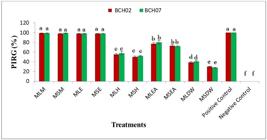| Tannins |
Ferric chloride test |
-About 0.5 g of methanolic extract was dissolved into 10ml of distilled water and filtered. |
(Harbone, 2001HARBONE, J.B., 2001. Phytochemical methods. London: Chapman and Hall Ltd, 113 pp.) |
| - 4-6 drops of 10% ferric chloride was then added into the filtrate. |
| Alkaloids |
Dragendorff’s test |
- Methanolic extract (0.2 g) was put into a conical flask, followed by the addition of 20 ml of sulphuric acid diluted in methanol. |
(Ghani, 1998GHANI, A., 1998. Medicinal plants of Bangladesh. Dhaka: Asiatic Society of Bangladesh, pp. 78-83.; Harbone, 2001HARBONE, J.B., 2001. Phytochemical methods. London: Chapman and Hall Ltd, 113 pp.). |
| - The mixture was then filtered and treated with 2 drops of Dragendorff’s reagents (Potassium bismuth iodide solution). |
| Flavonoids |
Ammonium test |
-About 10 ml of ethyl acetate was added to 0.2 g of the extract and heated in water bath for 4 min. |
(Harbone, 2001HARBONE, J.B., 2001. Phytochemical methods. London: Chapman and Hall Ltd, 113 pp.; Sofowora, 2005SOFOWORA, A., 2005. Medicinal plants and traditional medicine in Africa. Ibadan, Nigeria: Spectrum Books Ltd, 289 pp.)’ |
| -The mixture was allowed to be cooled and then filtered. |
| - 1 ml of diluted ammonia was shaken with 4 ml of the filtrate and the layers were allowed to separate. |
| Saponnins |
Froth test |
-About 20 ml of water was added to 0.25 g of the extract in 100 ml beaker, boiled and then filtered. |
(Harbone, 2001HARBONE, J.B., 2001. Phytochemical methods. London: Chapman and Hall Ltd, 113 pp.; Khalil et al., 2013KHALIL, A.S., RAHIM, A.A., TAHA, K.K. and ABDALLAH, K.B., 2013. Characterization of methanolic extracts of agarwood leaves. Journal of Applied and Industrial Sciences, vol. 1, no. 3, pp. 78-88.; Sofowora, 2005SOFOWORA, A., 2005. Medicinal plants and traditional medicine in Africa. Ibadan, Nigeria: Spectrum Books Ltd, 289 pp.). |
| -The filtrate (5 ml) was diluted with 20ml of distilled water and shaken vigorously. |
| -This was the allowed to stand. |
| Steroids/ Triterpenoids |
Liebermann-Burchardt test. |
-Methanolic extract (1 ml) was boiled with 2 ml of chloroform and allowed to cool. |
(Khalil et al., 2013KHALIL, A.S., RAHIM, A.A., TAHA, K.K. and ABDALLAH, K.B., 2013. Characterization of methanolic extracts of agarwood leaves. Journal of Applied and Industrial Sciences, vol. 1, no. 3, pp. 78-88.). |
| -Then 1-3 drops of concentrated sulphuric acid were added, shaken and allowed to stand. |
| Phenolic compounds |
Ferric chloride test |
-3 drops of 1% ferric chloride was added to 3ml portion of methanolic extract. |
(Harbone, 2001HARBONE, J.B., 2001. Phytochemical methods. London: Chapman and Hall Ltd, 113 pp.: Khalil et al., 2013KHALIL, A.S., RAHIM, A.A., TAHA, K.K. and ABDALLAH, K.B., 2013. Characterization of methanolic extracts of agarwood leaves. Journal of Applied and Industrial Sciences, vol. 1, no. 3, pp. 78-88.). |
| Anthraquinone |
Borntrager’s test |
-10ml of benzene was added to 4 g of the methanol extract, shaken and filtered. |
(Kadhim and Al-Shammaa, 2014KADHIM, E.J. and AL-SHAMMAA, D.A., 2014. Phytochemical characterisation using GC-MS analysis of methanolic extract of Moringa oleifera (Moringaceae) plant cultivated in Iraq. Chemistry and Materials Research, vol. 6, no. 5, pp. 9-26.). |
| -Then 5 ml of 10% ammonia solution was added to the filtrate, shaken and allowed to stand. |
| Terpenoids |
Salkowski test |
-The extract (2ml) was dissolved in chloroform (2ml) and then evaporated to dryness. |
(Kadhim and Al-Shammaa, 2014KADHIM, E.J. and AL-SHAMMAA, D.A., 2014. Phytochemical characterisation using GC-MS analysis of methanolic extract of Moringa oleifera (Moringaceae) plant cultivated in Iraq. Chemistry and Materials Research, vol. 6, no. 5, pp. 9-26.; Khalil et al., 2013KHALIL, A.S., RAHIM, A.A., TAHA, K.K. and ABDALLAH, K.B., 2013. Characterization of methanolic extracts of agarwood leaves. Journal of Applied and Industrial Sciences, vol. 1, no. 3, pp. 78-88.). |
| -Sulphuric acid (2ml) was added and boiled for 2 minutes. |

 Thumbnail
Thumbnail
 Thumbnail
Thumbnail
 Thumbnail
Thumbnail
 Thumbnail
Thumbnail
 Thumbnail
Thumbnail
















